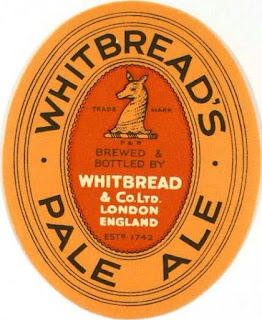The grist is near identical 80% base malt, 20% sugar. Though in this later version, the malt is split between 25% pale malt (made from Smyrna barley) and 75% of the classier PA malt. As usual. Whitbread couldn’t be arsed to record the type of sugar, leaving me to guess No. 1 invert.
One major change, which isn’t immediately apparent is a lowering of the hopping rate. Down from 15 lbs per quarter (336 lbs) of malt to just 9 lbs. Unsurprisingly, this has a considerable impact on the calculated bitterness level, dropping from 94 IBU to 61.5 IBU. Three types of East Kent hops from the 1908 season graced the copper. Goldings seems a fair enough guess as to the variety.
As this was probably still a Stock Ale, aged for many months, the true FG would have been considerably lower than the racking gravity listed in the table.
| 1909 Whitbread PA | ||
| pale malt | 10.25 lb | 80.39% |
| no. 1 sugar | 2.50 lb | 19.61% |
| Goldings 90 mins | 1.75 oz | |
| Goldings 60 mins | 1.75 oz | |
| Goldings 30 mins | 1.75 oz | |
| Goldings dry hops | 0.50 oz | |
| OG | 1062.7 | |
| FG | 1019 | |
| ABV | 5.78 | |
| Apparent attenuation | 69.70% | |
| IBU | 61.5 | |
| SRM | 8 | |
| Mash at | 151º F | |
| Sparge at | 165º F | |
| Boil time | 105 minutes | |
| pitching temp | 59º F | |
| Yeast | Wyeast 1099 Whitbread ale | |












































































3 comments:
How "pale" would this have been, do you think? Would it have looked pale to a 2021 eye, or would it be more like the pale ales of my youth (i.e. about as pale as Whitbread Tankard)?
Also, have you got any feel for when / how often people would actually drink this stuff? Given that it was a stock ale I assume it wouldn't be what most people were knocking back most of the time. (I'm making no assumptions about the strength of people's everyday go-to pint; as you say, Lloyd George was about to recalibrate expectations on that front fairly drastically - and enduringly.)
Phil,
it's hard to say exactly what the colour was. But, the fact that the grist was just pale malt and sugar implies something pretty pale. The higher gravity than modern Bitter would add some colour. Still at the pale end of the modern colour range would be my bet.
Phil,
not very much, is how much of PA was being drunk. It was a little over 1% of Whitbread's output: 9,939 of 860,823 barrels in 1909.
Post a Comment